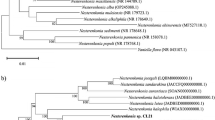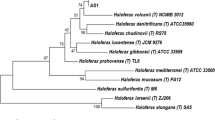Abstract
The genus Hymenobacter is classified in the family Hymenobacteraceae under the phylum Bacteroidetes. They have been isolated from diverse environments, such as air, soil, and lichen, along with extreme polar environments, including the Arctic and Antarctic regions. The polar regions have attracted intense research interest for the discovery of novel microorganisms and their functions. Analysis of the polysaccharide utilization-related carbohydrate-active enzyme among the two lichen-associated polar organisms Hymenobacter sp. PAMC 26554 and Hymenobacter sp. PAMC 26628 was performed, along with its comparison with the complete genome of the same genus available in the NCBI database. The study was conducted relying on the AZCL screening data for the two polar lichen-associated species. While comparing with eight other complete genomes, differences in polysaccharide preferences based on the isolation environment and biosample source were discovered. All the species showed almost similar percentage of cellulose synthesis and degradation genes. However, the polar lichen-associated microorganism was found to have a high percentage of hemicellulose degradation genes, and less starch and laminarin degradation. The Hymenobacter species with higher number of hemicellulose degradation genes was found to have a lower number of starch and laminarin degradation genes and vice versa, highlighting the differences in polysaccharide utilization among the species.





Similar content being viewed by others
References
Ma R, Huang H, Bai Y, Luo H, Fan Y, Yao B (2018) Insight into the cold adaptation and hemicellulose utilization of Cladosporium neopsychrotolerans from genome analysis and biochemical characterization. Sci Rep 8(1):6075
Huang C, Huang F, Zhang X, Liu D (2017) Lv J (2017) The contribution of geomagnetic activity to polar ozone changes in the upper atmosphere. Adv Meteorol 28:1–7
Stefanidi E, Vorgias CE (2008) Molecular analysis of the gene encoding a new chitinase from the marine psychrophilic bacterium Moritella marina and biochemical characterization of the recombinant enzyme. Extremophiles 12(4):541–552
Ueda M, Goto T, Nakazawa M, Miyatake K, Sakaguchi M, Inouye K (2010) A novel cold-adapted cellulase complex from Eisenia foetida: Characterization of a multienzyme complex with carboxymethylcellulase, β-glucosidase, β-1,3 glucanase, and β-xylosidase. Comp Biochem Physiol B 157(1):26–32
Cavicchioli R, Charlton T, Ertan H, Omar SM, Siddiqui KS, Williams TJ (2011) Biotechnological uses of enzymes from psychrophiles. Microb Biotechnol 4(4):449–460
Bennke CM, Krüger K, Kappelmann L, Huang S, Gobet A, Schüler M et al (2016) Polysaccharide utilisation loci of Bacteroidetes from two contrasting open ocean sites in the North Atlantic. Environ Microbiol 18(12):4456–4470
Xing P, Hahnke RL, Unfried F, Markert S, Huang S, Barbeyron T et al (2015) Niches of two polysaccharide- Polaribacter isolates from the North Sea during a spring diatom bloom. ISME J 9(6):1410–1422
Li S, Hao J, Sun M (2017) Cloning and characterization of a new cold-adapted and thermo-tolerant ι-carrageenase from marine bacterium Flavobacterium sp. YS-80-122. Int J Biol Macromol 102:1059–1065
Berlemont R (2017) Distribution and diversity of enzymes for polysaccharide degradation in fungi. Sci Rep 7(1):222
Tanackovic V, Rydahl MG, Pedersen HL, Motawia MS, Shaik SS, Mikkelsen MD et al (2016) High throughput screening of starch structures using carbohydrate microarrays. Sci Rep 6:30551
Field CB, Behrenfeld MJ, Randerson JT, Falkowski P (1998) Primary production of the biosphere: Integrating terrestrial and oceanic components. Science 281(5374):237–240
Montella S, Ventorino V, Lombard V, Henrissat B, Pepe O, Faraco V (2017) Discovery of genes coding for carbohydrate-active enzyme by metagenomic analysis of lignocellulosic biomasses. Sci Rep 7:42623
Convey P (2006) Antarctic climate change and its influences on terrestrial ecosystems. Trends in antarctic terrestrial and limnetic ecosystems: antarctica as a global indicator. Springer, Dordrecht, pp 253–272
Sancho LG, Pintado A, Green TGA (2019) Antarctic studies show lichens to be excellent biomonitors of climate change. Diversity 11(3):42
Zhang T, Wei XL, Zhang YQ, Liu HY, Yu LY (2015) Diversity and distribution of lichen-associated fungi in the Ny-Ålesund region (Svalbard, High Arctic) as revealed by 454 pyrosequencing. Sci Rep 5:14850
Olafsdottir ES, Ingólfsdottir K (2001) Polysaccharides from lichens: Structural characteristics and biological activity. Planta Med 67(3):199–208
Lombard V, Golaconda Ramulu H, Drula E, Coutinho PM, Henrissat B (2014) The carbohydrate-active enzymes database (CAZy) in 2013. Nucleic Acids Res 42:D490–D495
Helbert W, Poulet L, Drouillard S, Mathieu S, Loiodice M, Couturier M et al (2019) Discovery of novel carbohydrate-active enzymes through the rational exploration of the protein sequences space. Proc Natl Acad Sci USA 116(13):6063–6068
Smalås AO, Leiros HKS, Os V, Willassen NP (2000) Cold adapted enzymes. Biotechnol Annu Rev 6:1–57
Jin L, Wu X, Ko SR, Jin FJ, Li T, Ahn CY et al (2018) Description of Hymenobacter daejeonensis sp. nov., isolated from grass soil, based on multilocus sequence analysis of the 16S rRNA gene, gyrB and tuf genes. Antonie van Leeuwenhoek. Int J Gen Mol Microbiol 111(12):2283–2292
Hirsch P, Ludwig W, Hethke C, Sittig M, Hoffmann B, Gallikowski CA (1998) Hymenobacter roseosalivarius gen. nov., sp. nov. from continental Antarctic soils and sandstone: bacteria of the Cytophaga/Flavobacterium/Bacteroides line of phylogenetic descent. Syst Appl Microbiol 21(3):374–383
Buczolits S, Denner EBM, Kämpfer P, Busse HJ (2006) Proposal of Hymenobacter norwichensis sp. nov., classification of “Taxeobacter ocellatus”, “Taxeobacter gelupurpurascens” and “Taxeobacter chitinovorans” as Hymenobacter ocellatus sp. nov., Hymenobacter gelipurpurascens sp. nov. and Hymenobacter chitinivorans sp. nov., respectively, and emended description of the genus Hymenobacter Hirsch et al. 1999. Int J Syst Evol Microbiol 56(Pt 9):2071–2078
Oh TJ, Han SR, Ahn DH, Park H, Kim AY (2016) Complete genome sequence of Hymenobacter sp. strain PAMC26554, an ionizing radiation-resistant bacterium isolated from an Antarctic lichen. J Biotechnol 227:19–20
Tang K, Lin Y, Han Y, Jiao N (2017) Characterization of potential polysaccharide utilization systems in the marine Bacteroidetes Gramella flava JLT2011 using a multi-omics approach. Front Microbiol 8:220
Ransom-Jones E, McCarthy AJ, Haldenby S, Doonan J, McDonald JE (2017) Lignocellulose-degrading microbial communities in landfill sites represent a repository of unexplored biomass-degrading diversity. mSphere 2(4):e00300-17
Solden LM, Hoyt DW, Collins WB, Plank JE, Daly RA, Hildebrand E et al (2017) New roles in hemicellulosic sugar fermentation for the uncultivated Bacteroidetes family BS11. ISME J 11(3):691–703
De Fine Licht HH, Schiøtt M, Mueller UG, Boomsma JJ (2010) Evolutionary transitions in enzyme activity of ant fungus gardens. Evolution 64(7):2055–2069
Ten LN, Im WT, Kim MK, Kang MS, Lee ST (2004) Development of a plate technique for screening of polysaccharide-microorganisms by using a mixture of insoluble chromogenic substrates. J Microbiol Methods 56(3):375–382
Zhang H, Yohe T, Huang L, Entwistle S, Wu P, Yang Z et al (2018) DbCAN2: A meta server for automated carbohydrate-active enzyme annotation. Nucleic Acids Res 46(W1):W95–W101
Béguin P, Aubert JP (1994) The biological degradation of cellulose. FEMS Microbiol Rev 13(1):25–58
Brumm PJ (2013) Bacterial genomes: what they teach us about cellulose degradation. Biofuels 4(6):669–681
Wood TM (1992) Fungal cellulases. Biochem Soc Trans 20(1):46–53
López-Mondéjar R, Zühlke D, Becher D, Riedel K, Baldrian P (2016) Cellulose and hemicellulose decomposition by forest soil bacteria proceeds by the action of structurally variable enzymatic systems. Sci Rep 6:25279
Valk V, Eeuwema W, Sarian FD, van der Kaaij RM, Dijkhuizen L (2015) Degradation of granular starch by the bacterium Microbacterium aurum strain B8.A involves a modular α-amylase enzyme system with FNIII and CBM25 domains. Appl Environ Microbiol 81(19):6610–6620
de Souza PM, de Oliveira MP (2010) Application of microbial α-amylase in industry: a review. Braz J Microbiol 41(4):850–861
Qin HM, Miyakawa T, Inoue A, Nakamura A, Nishiyama R, Ojima T et al (2017) Laminarinase from Flavobacterium sp. reveals the structural basis of thermostability and substrate specificity. Sci Rep 7(1):11425
Perez CMT, Pajares IG, Alcantara VA, Simbahan JF (2018) Bacterial laminarinase for application in ethanol production from brown algae Sargassum sp. using halotolerant yeast. Biofuel Res J 5(1):792–797
Sun C, Fu GY, Zhang CY, Hu J, Xu L, Wang RJ et al (2016) Isolation and complete genome sequence of Algibacter alginolytica sp. nov., a novel seaweed: bacteroidetes bacterium with diverse putative polysaccharide utilization loci. Appl Environ Microbiol 82(10):2975–2987
Lapébie P, Lombard V, Drula E, Terrapon N, Henrissat B (2019) Bacteroidetes use thousands of enzyme combinations to break down glycans. Nat Commun 10(1):2043
Thomas F, Hehemann JH, Rebuffet E, Czjzek M, Michel G (2011) Environmental and gut bacteroidetes: the food connection. Front Microbiol 2:93
Despres J, Forano E, Lepercq P, Comtet-Marre S, Jubelin G, Yeoman CJ et al (2016) Unraveling the pectinolytic function of Bacteroides xylanisolvens using a RNA-seq approach and mutagenesis. BMC Genomics 17:147
Parvizpour S, Razmara J, Shamsir MS, Illias RM, Abdul Murad AM (2017) The role of alternative salt bridges in cold adaptation of a novel psychrophilic laminarinase. J Biomol Struct Dyn 35(8):1685–1692
Gawor J, Grzesiak J, Sasin-Kurowska J, Borsuk P, Gromadka R, Górniak D et al (2016) Evidence of adaptation, niche separation and microevolution within the genus Polaromonas on Arctic and Antarctic glacial surfaces. Extremophiles 20(4):403–413
Pointing SB, Büdel B, Convey P, Gillman LN, Körner C, Leuzinger S et al (2015) Biogeography of photoautotrophs in the high polar biome. Front Plant Sci 6:692
Brunecky R, Chung D, Sarai NS, Hengge N, Russell JF, Young J et al (2018) High activity CAZyme cassette for improving biomass degradation in thermophiles. Biotechnol Biofuels 11:22
Wilkens C, Busk PK, Pilgaard B, Zhang WJ, Nielsen KL, Nielsen PH et al (2017) Diversity of microbial carbohydrate-active enzymes in Danish anaerobic digesters fed with wastewater treatment sludge. Biotechnol Biofuels 10:158
Acknowledgement
This work was supported by the Korea Polar Research Institute (KOPRI Grant No. PM20030).
Author information
Authors and Affiliations
Corresponding authors
Ethics declarations
Conflict of interest
The authors declare that they have no conflict of interest.
Additional information
Publisher's Note
Springer Nature remains neutral with regard to jurisdictional claims in published maps and institutional affiliations.
Rights and permissions
About this article
Cite this article
Ghimire, N., Han, SR., Kim, B. et al. Comparative Genomic Study of Polar Lichen-Associated Hymenobacter sp. PAMC 26554 and Hymenobacter sp. PAMC 26628 Reveals the Presence of Polysaccharide-Degrading Ability Based on Habitat. Curr Microbiol 77, 2940–2952 (2020). https://doi.org/10.1007/s00284-020-02120-1
Received:
Accepted:
Published:
Issue Date:
DOI: https://doi.org/10.1007/s00284-020-02120-1




